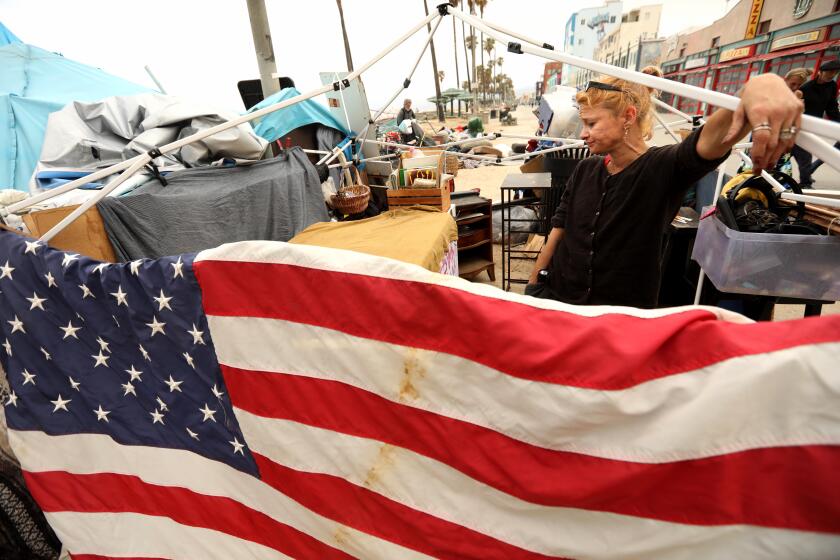Column One: In Redondo Beach, it’s homeless court alfresco — with love
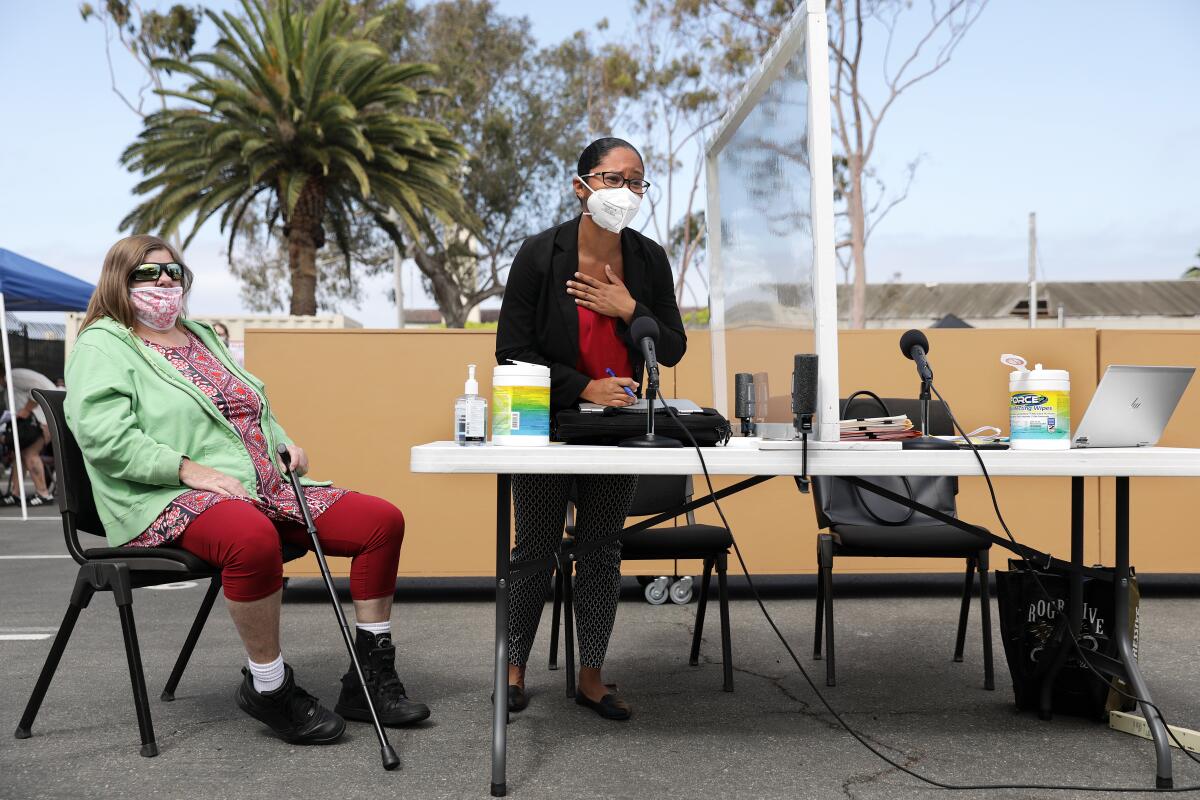
- Share via
The defendants sat on folding chairs in a parking lot under a dappled sky.
“Miss Scott, come on up here,” Judge Rene Gilbertson said from behind an elevated desk. “Take your time.”
Recovering meth addict Michelle Scott limped on her cane to the folding table where the public defender sat.
“Miss Scott, you know what I’m getting ready to ask you,” Gilbertson said. “How many days sober?”
“Six hundred,” Scott said.
The other defendants broke into applause.
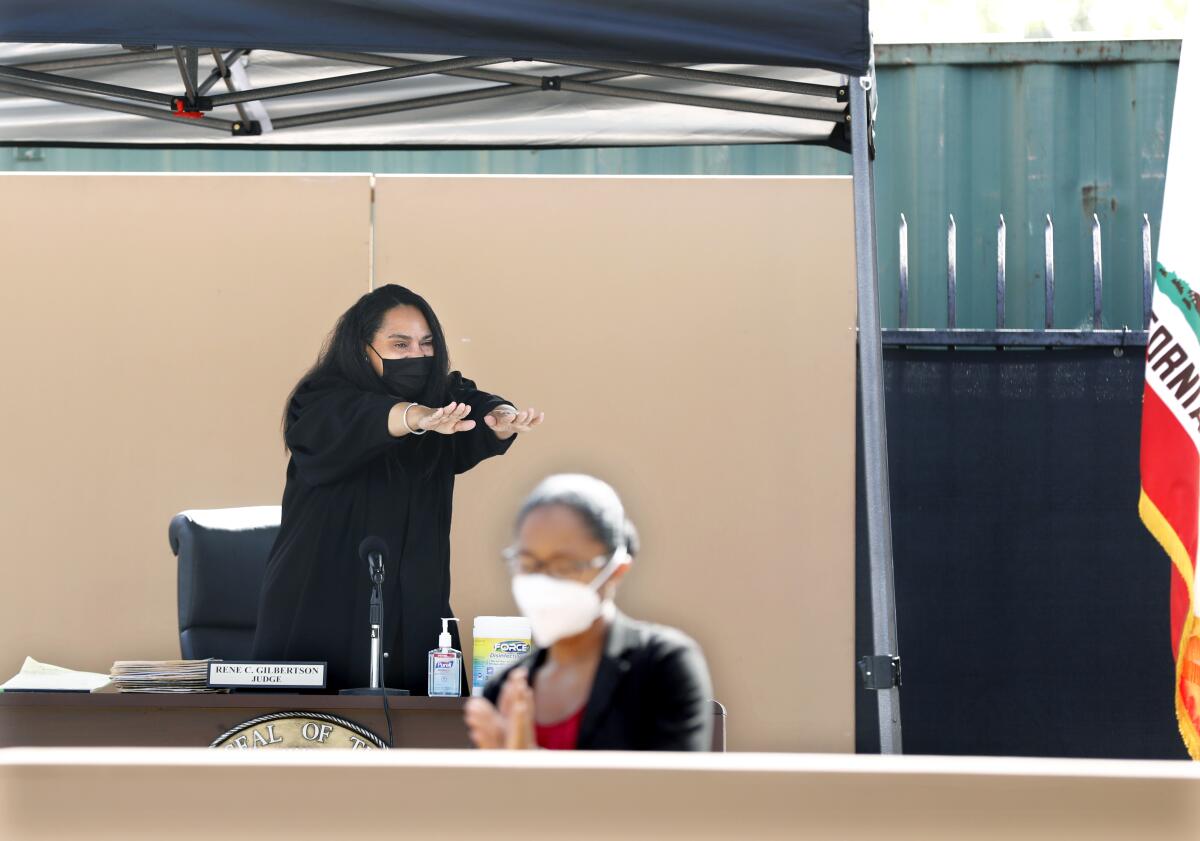
The outdoor court had convened behind the Redondo Beach Police Department’s Investigations Division, a pandemic adaptation that has proved so popular it will live on even after the all-clear comes to resume proceedings in the traditionally staid and, relatively speaking, distant courthouse in Torrance.
The informality of the setting, and its location in the seaside town where all the defendants were arrested, strike a perfect harmony with the court’s roots in a growing national movement to make services rather than custody the aim for misdemeanor prosecutions that customarily send homeless people to jail.
“The goal of this program is to assist with obtaining permanent housing,” Gilbertson said in a preamble to the session, capturing the difference between her court and the adversarial model designed to determine guilt or innocence. “It will be a lot of work for you.”
First up in the day’s cases was a graduation.
Facing 2019 charges of possession of methamphetamine and drug paraphernalia, Stanley Spence had completed the court supervision program.
Spence, a gray-haired, gangly man, sat beside the public defender’s table with what looked like a self-conscious smile behind his black mask. His case manager from Harbor Interfaith Services recounted his story.
“He was homeless a long time, years on the streets,” Matthew Morash said. “We were trying to find a solution.”
A plan for how to solve Venice’s homeless crisis has emerged from behind-the-scenes talks among a coalition of Venice activists, city officials and deputies of the area’s city councilman.
He got a break in December when the city opened a shelter on a former public works yard.
There was an opening for Spence in one of the 15 tiny homes, and he started working with the homeless services provider PATH to find housing.
“Everything just fell into place,” Morash said. “Now he’s off the streets and he’s working.”
Gilbertson led a round of applause with a bow toward Spence.
“One more thing,” she said. “We are going on the record. People vs. Stanley Spence. It gives me great pleasure to move to dismiss this case in the interest of justice. Congratulations. You’ve earned it.”
The city’s homeless court began in the fall of 2019 in response to community pressure. Residents were coming to City Council meetings to complain about deteriorating quality of life, directing their anger in particular at four churches that were serving meals to homeless people, City Atty. Michael Webb said.
Consulting with the police, service providers and constituents, Webb concluded that untreated mental illness and substance abuse were behind the cycle of repeated arrests for public disturbances.
“There is a woeful inadequacy of mental health care in the county,” Webb said. “It can be tough for anyone to change. We tried to make it as easy as possible for them to succeed.”
The responsibility fell to Gilbertson by chance. A recent appointee to the Superior Court, she had been given the Redondo Beach docket. The fit couldn’t have been better. With a background in child advocacy, she has an empathetic manner rarely seen on the bench.
In her court, defendants have the status of family members. Praising, encouraging and, when necessary, lightly admonishing defendants, she leaves no doubt that the court’s will is for them to succeed.
“Miss Scott,” she said. “You know that you have long deserved one of these graduation certificates.”
The fault was not Scott’s, but the obstacles to obtaining her birth certificate from her birthplace in Nevada. She can’t apply for an apartment until she gets it.
“I’ve spoken to the lawyers, and I’ve even done some research regarding your birth certificate,” Gilbertson said.
Lawyers on the case are working on that. In the meantime, she said, Scott is a model for the new enrollees in the program.
“A lot of times when you’re starting out it looks impossible, and you give people that inspiration,” she said. “It is not impossible.”
Then she asked, “What about smoking?”
It had been 278 days, Scott replied.
“That’s incredible,” she said. “Just hang in there.”

The homeless court convenes one morning each month to hear cases selected by Redondo Beach prosecutors for diversion.
Candidates are nonviolent offenders who are arrested, often repeatedly, for quality-of-life crimes such as public drunkenness, trespassing and drug violations. Often they’re referred by homeless services agencies, and they can only enter the program voluntarily.
Once in, they surrender their right to a speedy trial and must return to the court regularly to report on their compliance with any treatment ordered by the judge. They remain under the court’s supervision until they obtain a home.
In the beginning, case managers for the city’s service providers drove their clients to her courtroom miles away in the Torrance Courthouse.
Then the program was abruptly interrupted last spring when the pandemic curtailed court operations and made the transportation problematic.
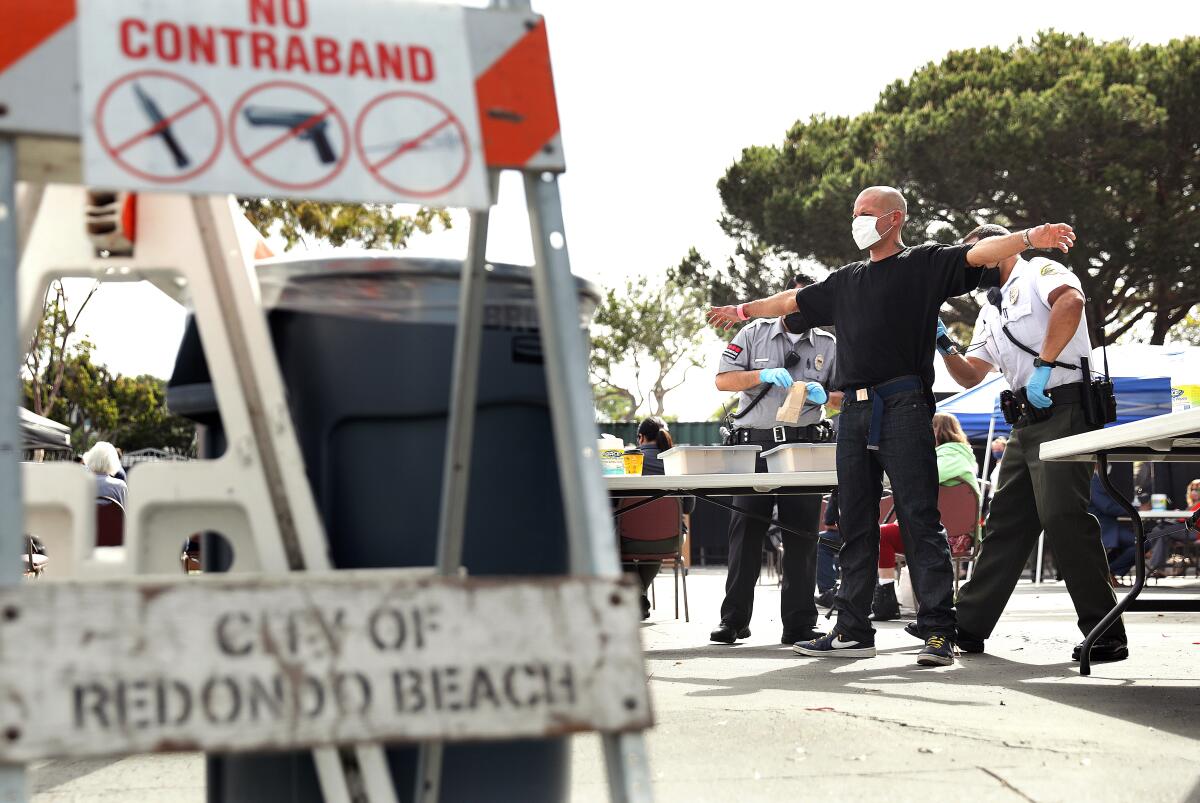
“We were trying to figure out a workaround,” City Councilman Christian Horvath said. “How could we get it back up and running?”
The answer was to go outdoors. The city’s Public Works Department built a wooden box on wheels for the bar — the divider between the attorneys and the public — and hung plywood sheets on the parking lot fence to give a more formal background to the bench, improvised with an office desk on a portable stage. Court reopened in September.
“All of us in my office didn’t sleep well the night before,” Webb said. “You’re having an outdoor court in a parking lot. There were so many things that could go wrong.”
Instead, Webb quickly saw that the benefits went well beyond COVID prevention. The setting, across the street from St. James Catholic Church, where homeless people congregate for food, was less intimidating than a courtroom. And access to service providers was immediate.
“Now it is: ‘Go see Mr. Johnson. He’s wearing a blue shirt raising his hand,’ ” Webb said. “They can get offered mental health services in more of a supportive environment.”
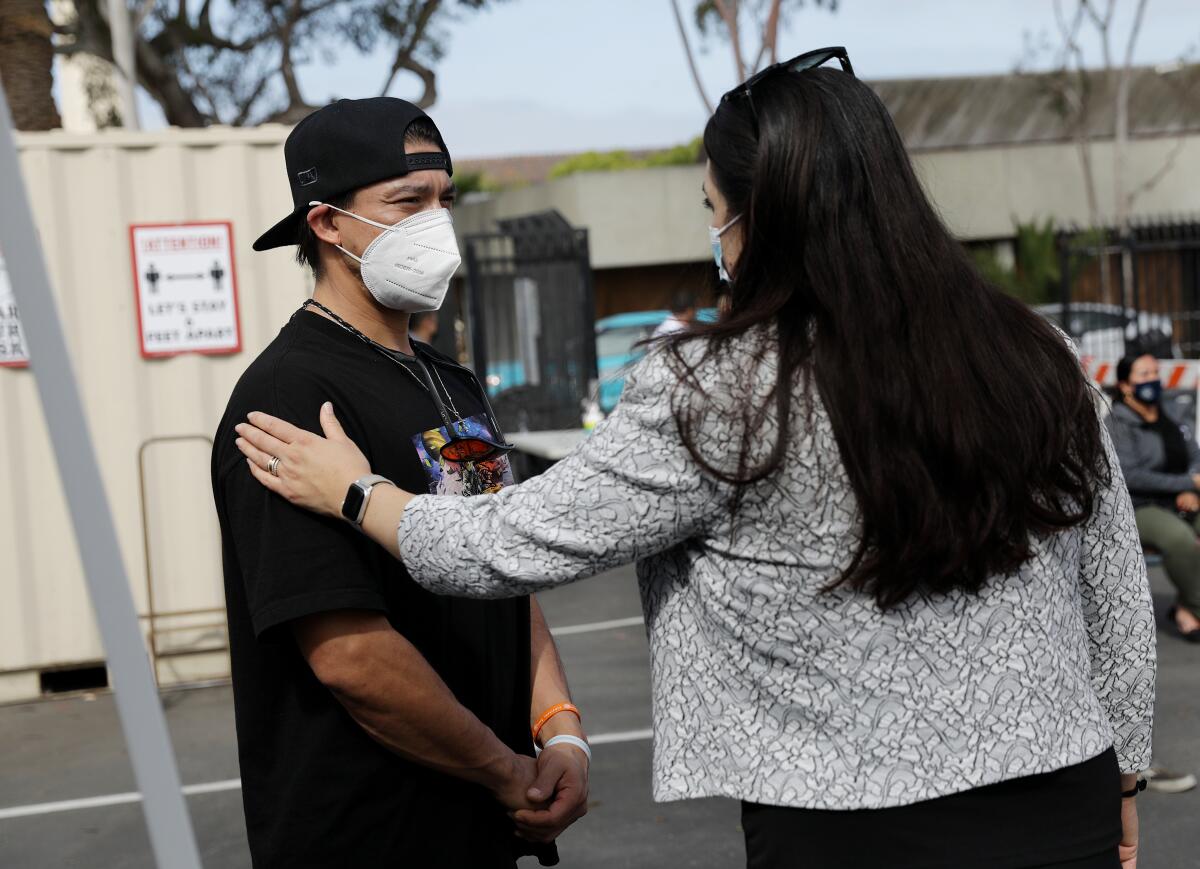
Participation rates jumped, Webb said.
Now, even as the pandemic restrictions are easing, the city has asked, and the court has agreed, to continue the outdoor court. Some modifications may be required.
At one point during the session, the sun popped through. Gilbertson advised the defendants to get some water and go sit under one of the tents set up for the service providers.
Webb said he made a mental note to have more tents for the next session.
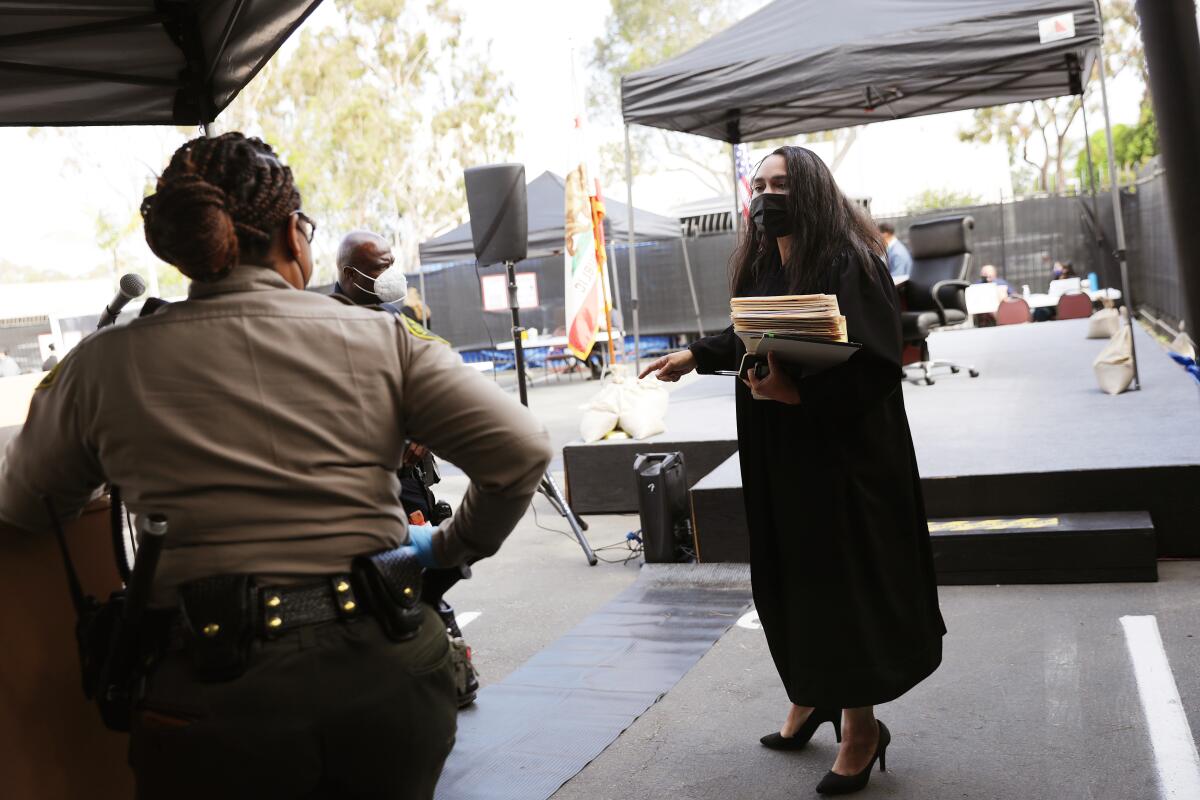
Though unique in its setting, Redondo Beach’s homeless court draws its basic form from a model that originated in San Diego three decades ago. In 1989, then-Deputy Public Defender Steve Binder set up a court process to help homeless veterans clear bench warrants. It grew into the San Diego Homeless Court Program, a model that’s been adopted in about 70 homeless courts around the country from Salt Lake City to Detroit.
The American Bar Assn. promotes homeless courts and provides technical assistance to help cities start them. Common elements are voluntary participation, dismissal of charges without custody and supervised activities to address the underlying cause of the offense.
But there’s no strict blueprint for homeless courts, said Caitlin Flood, senior program manager for the New York-based Center for Court Innovation.
“While it’s a model with principles and best practices, every jurisdiction is doing this differently to be responsive to community needs,” she said.
In Los Angeles, mobile teams of city attorneys and public defenders travel to parks, libraries and shelters to help homeless people expunge past convictions and clear current citations.
Santa Monica has been conducting a homeless court for minor infractions since 2007. The court was held in the LAX Courthouse until the coronavirus lockdowns and has recently resumed with the defendants gathering at a local service provider and the judge and attorneys appearing by videoconference.
Long Beach is launching a homeless court next month. Initially it will be by videoconference.
The common theme is getting homeless people the help they need to stay out of the justice system.
“You have to be very forgiving and understand we are dealing with a unique population,” said Senior Deputy City Atty. Anastasia Papadakis, who leads the program. “They may pick up more cases. That’s not going to kick them out of homeless court. It provides us some leverage.”
It’s not certain, though, how long the outdoor court will live.
Torrance presiding Judge Eric C. Taylor said it is a pilot that will be evaluated in an environment of reduced budgets.
“While we’d like to do more things like this if they work and we have the resources, we have to be very cautious about how we move forward,” Taylor said.
In Redondo Beach, Gilbertson’s orders range from working with a case manager on simple goals like getting a driver’s license to meeting with the representative from Clear Recovery Center in Redondo Beach or the County Department of Mental Health, both standing by.
The court’s capacity for mercy can be tested.
In the calling of People vs. Randall Gibson, Gilbertson first read off a list of his nine case numbers.
“Good morning, Mr. Gibson,” she said. “Sorry I had to read your cases.”
The report from Papadakis was not good. He was facing five new charges.
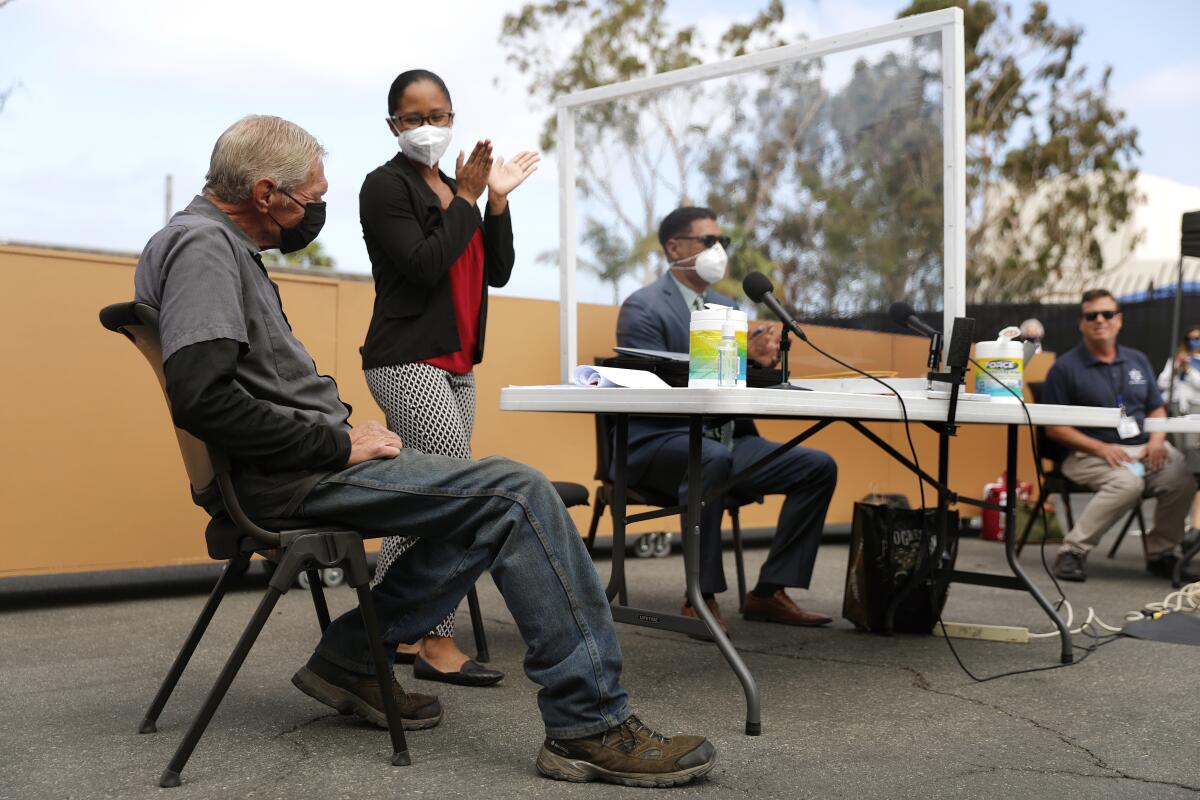
“Mr. Gibson is very close to going from misdemeanor to felony,” she said. “We can’t really help him if he keeps picking up more serious cases.”
The force of the law came down with a gentle touch. Gilbertson acknowledged that his presence showed he wanted to turn his life around and accept help.
“But, as many arms are extended to you, and I told you before, you got to reach out and grab their hands,” she said. “They can try all they want.
“When you come next time, I don’t want to hear you got arrested again,” she said. “I want to hear you’ve gotten your ID and you’re headed in a different direction, a different direction than you’re going in now. Because this stack of cases, that’s not you. You’ve got to be the you that you must be. All right?
“Enough of my speech,” she closed. “Let’s do it.”
More to Read
Sign up for Essential California
The most important California stories and recommendations in your inbox every morning.
You may occasionally receive promotional content from the Los Angeles Times.
